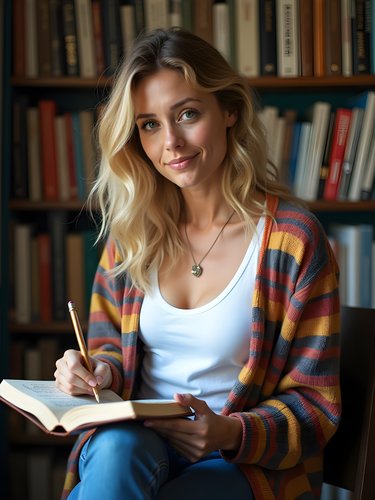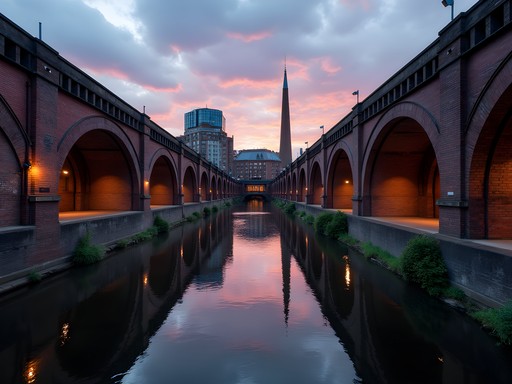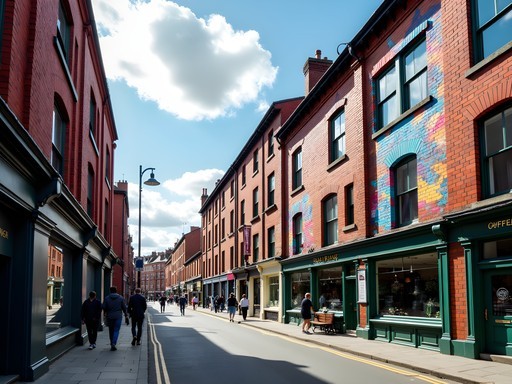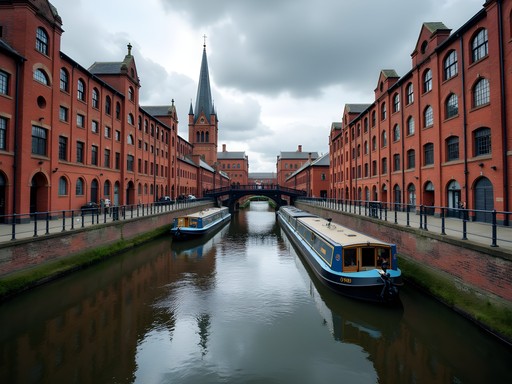Disclosure: This article contains affiliate links. We may earn a commission from purchases at no extra cost to you, which helps our travel content.
Standing in the drizzle beside Castlefield Basin, I watch as raindrops create concentric circles across water that once carried the lifeblood of Britain's industrial revolution. Manchester isn't just another brick-laden northern city—it's a living museum where ecology and industry have created a unique urban ecosystem. As a conservation scientist who's explored reefs and rainforests, I've developed an unexpected fascination with how nature reclaims industrial landscapes, and Manchester offers one of Europe's most compelling case studies. Join me for a weekend of discovery through this resilient city's hidden corners without breaking the bank.
Castlefield: Where Rome Meets Revolution
Castlefield represents the perfect starting point for any industrial exploration of Manchester, where Roman foundations literally underpin the birthplace of the industrial revolution. This conservation area contains the world's first industrial canal, the Bridgewater Canal, which transformed global commerce when it opened in 1761.
What fascinates me as a scientist is the resilience of this ecosystem. The once-polluted waterways now support a surprising diversity of urban wildlife—kingfishers dart along the canals while native wildflowers reclaim the towpaths. The area exemplifies how industrial heritage can evolve into biodiverse urban spaces.
Explore the reconstructed Roman fort (Mamucium), then wander beneath the massive Victorian railway viaducts that create cathedral-like spaces below. I spent hours photographing the interplay of brick, water, and regenerating plant life with my waterproof notebook (essential for Manchester's unpredictable weather). The juxtaposition of ancient and industrial infrastructures creates a uniquely Mancunian palimpsest that tells the story of 2,000 years of urban development.

💡 Pro Tips
- Visit early morning (before 9am) to photograph the canals without crowds
- The Castlefield Hotel offers affordable accommodation directly in the heritage area
- Look for the hidden interpretation panels that explain the ecological recovery of the canal system
Ancoats: The World's First Industrial Suburb
Just northeast of the city center lies Ancoats, once known as 'the world's first industrial suburb' and now one of Manchester's most compelling urban regeneration stories. This compact neighborhood packs an incredible density of industrial history into its grid of streets.
The massive red-brick mill buildings that once housed deafening cotton production now contain everything from artisanal bakeries to tech startups. What makes Ancoats special is how thoughtfully much of this repurposing has been done—many buildings maintain their original architectural features while finding new purpose.
My scientific background draws me to the Royal Mill complex, where the innovative use of cast iron and brick created fire-resistant structures that revolutionized industrial architecture globally. The nearby Ancoats Marina provides another perspective on how industrial infrastructure can be repurposed for leisure and habitat creation.
I highly recommend bringing a foldable water bottle for your explorations—Manchester's tap water is excellent, and reducing plastic waste should be every traveler's priority. The bottle's flexible design makes it easy to stash in your daypack when empty.

💡 Pro Tips
- Join the free Ancoats walking tour on Saturday mornings (starts at Cutting Room Square)
- Visit Hallé St Peter's, a deconsecrated church transformed into a stunning performance venue
- Look for the subtle ghost signs on buildings that reveal their industrial past
Manchester's Hidden Waterways: The Underground Canals
Few visitors realize that beneath Manchester's streets lies a network of forgotten waterways that once formed the city's industrial circulatory system. The most fascinating is the Manchester & Salford Junction Canal, built in 1839 to link the Rochdale Canal with the River Irwell.
Largely abandoned and partially bricked up during WWII, sections of this underground canal network remain accessible to determined urban explorers. During my research visit, I joined a specialized tour that accessed a 400-meter stretch beneath the Great Northern Warehouse complex, where brick arches and still waters create an eerie subterranean atmosphere.
The ecology of these spaces is fascinating—despite minimal light, specialized biofilms and fungi have colonized the damp brick surfaces, creating microhabitats unlike anything above ground. For photography in these low-light conditions, I relied on my headlamp, which provides hands-free illumination essential for navigating and documenting these dark spaces safely.
While some underground sections require guided tours with special permission, several access points allow glimpses into this hidden world, including the visible tunnel entrance near Deansgate.

💡 Pro Tips
- Book underground canal tours months in advance as they sell out quickly
- The Rochdale Canal offers above-ground alternatives with industrial heritage
- Respect safety barriers—many underground sections are genuinely dangerous without proper equipment
Mayfield Depot: Urban Wilderness in Transition
The Mayfield Depot represents Manchester's industrial heritage in raw, unfiltered form. This abandoned railway station and goods yard sat derelict for decades, creating an accidental urban wilderness where nature reclaimed the industrial landscape—a process ecologists call 'spontaneous rewilding.'
During my exploration, I documented over 24 plant species that had colonized the crumbling platforms and tracks, including several rare urban specialists that thrive in disturbed environments. The site demonstrates the remarkable resilience of nature when given space to recover, even in highly urbanized settings.
While the site is currently undergoing redevelopment as Mayfield Park (Manchester's first new city park in over 100 years), portions retain their wild, post-industrial character. For urban explorers interested in the intersection of industrial decay and ecological succession, it's a must-visit location.
I recommend bringing a plant identification app to identify the diverse urban flora you'll encounter. Understanding what's growing in these post-industrial spaces provides fascinating insights into urban ecology and natural regeneration processes.

💡 Pro Tips
- Check the Mayfield Partnership website for public access days during the ongoing redevelopment
- The northern section offers the best examples of spontaneous rewilding
- Visit at sunset when the light creates dramatic silhouettes of the industrial structures
Sustainable Industrial Tourism: The Northern Quarter's Maker Spaces
Manchester's Northern Quarter represents the sustainable future of industrial heritage—where making things remains central but in reimagined, ethical forms. This neighborhood has transformed from textile manufacturing to a creative hub where traditional crafts meet contemporary design.
The most fascinating aspect for budget travelers is the network of maker spaces and workshops that offer drop-in classes. At Manchester Craft & Design Centre (housed in a former Victorian fish market), I participated in a textile printing workshop using traditional techniques once employed in Manchester's massive cotton industry.
For those interested in sustainable fashion—a passion of mine given the environmental impact of fast fashion—the area offers excellent vintage and upcycled clothing shops. I found an amazing repurposed worker's jacket from a former Manchester cotton mill at Pop Boutique.
To document my explorations through the Northern Quarter's narrow streets and hidden courtyards, I used my pocket sketchbook to capture architectural details and street art that tells the story of Manchester's industrial evolution. Sketching creates a deeper connection to places than simply photographing them, forcing you to observe details you might otherwise miss.

💡 Pro Tips
- Check the Manchester Craft & Design Centre website for free demonstrations and exhibitions
- Many maker spaces offer affordable drop-in sessions where you can learn traditional industrial crafts
- The best street art documenting industrial heritage is found on Tariff Street and Dale Street
Final Thoughts
As I board my train at Manchester Victoria Station—itself a magnificent blend of Victorian engineering and modern design—I reflect on how this city challenges our perception of industrial heritage. Beyond the obvious landmarks and museums lies a complex urban ecosystem where past and future, nature and industry exist in dynamic tension. Manchester's story isn't simply about abandoned factories; it's about resilience, adaptation, and finding sustainable paths forward.
For the budget-conscious urban explorer, Manchester offers exceptional value—many industrial heritage sites are freely accessible, affordable guided tours provide deeper insights, and the compact city center makes exploration possible primarily on foot. More importantly, the city provides a masterclass in how industrial centers can evolve without erasing their heritage.
As a conservation scientist, I'm heartened by Manchester's growing emphasis on integrating green spaces and sustainable practices into its post-industrial identity. The city demonstrates that urban exploration can be both educational and environmentally conscious. So pack your waterproof notebook, comfortable shoes, and curiosity—Manchester's industrial secrets are waiting for those willing to look beyond the obvious.
✨ Key Takeaways
- Manchester's industrial heritage sites offer insights into both human history and urban ecology
- Budget exploration is highly accessible through free sites, affordable tours, and walkable distances
- The city demonstrates successful models of repurposing industrial infrastructure for sustainable futures
- Urban explorers will find unique photography opportunities where nature meets industrial architecture
- Manchester's industrial story continues to evolve, making it worth revisiting as regeneration projects progress
📋 Practical Information
Best Time to Visit
Year-round, though spring and autumn offer ideal light for photography and comfortable temperatures for walking
Budget Estimate
£150-250 for a weekend (accommodation, food, and selected tours)
Recommended Duration
2-3 days minimum to explore industrial heritage sites properly
Difficulty Level
Intermediate - Involves Significant Walking And Some Navigation Of Complex Urban Spaces
















Comments
citylife
Great post! If anyone's planning to explore these industrial sites, I highly recommend getting a day pass for the tram. Most of these spots are within walking distance of tram stops and it makes getting around super easy. Also, the free walking tour that starts at the Central Library covers some of Castlefield and the guides really know their history!
wanderlustzone
Thanks for the tram tip! Do they run late? Thinking about catching some night photos of those canal bridges.
citylife
They run until around midnight on weekdays and later on weekends. Perfect for evening photography!
Douglas Bradley
Elena, your piece on Manchester's industrial heritage really captures the essence of what makes this city so special. I spent a week exploring Manchester last year and was particularly impressed by Ancoats. The way those old mills have been transformed while preserving their character is urban regeneration done right. I'd also recommend visitors check out the Museum of Science and Industry - it's housed in the world's oldest railway station and has some fantastic exhibits on Manchester's role in textile manufacturing. The working steam engines they demonstrate on weekends are particularly impressive. I found that using a pocket guidebook was perfect for navigating between these industrial sites while providing historical context.
redphotographer
Great post! I'm heading to Manchester next month specifically for urban photography. Is Mayfield Depot still accessible? I heard they were redeveloping it and wasn't sure if you can still explore there?
Douglas Bradley
I was there about two months ago - parts of Mayfield are now under active redevelopment, but there's still plenty to photograph! The contrast between the decaying industrial structures and the new construction makes for some fascinating shots. Just check their website before going as some areas are only open during specific events.
wanderlustzone
Wow Elena! I had no idea Manchester had such a rich industrial history. Definitely adding those underground canals to my bucket list!
citylife
The underground canals are amazing! I did a boat tour last summer and it was like traveling back in time.
wanderlustzone
Oh nice! Did you need to book in advance? Planning a weekend trip there soon.
citylife
Yeah definitely book ahead, especially on weekends! The tours fill up fast.
adventuremood
Love your photos of Mayfield Depot! Is it easy to access or do you need special permission? Planning a trip in December.
Elena Wells
Thanks! Mayfield has actually been partially developed now - there are regular events and markets in the main space, but some areas are still under development. No special permission needed for the public areas, but check their website for opening times. December should be lovely with the winter markets!
adventuremood
Perfect! Adding it to my itinerary. Any good spots for rainy days? I hear Manchester gets a bit wet in winter 😅
luckystar
Not the author but when I visited last year, the People's History Museum was amazing on a rainy day. All about working class history and the industrial revolution. Really interactive too!
Frank Garcia
Great post Elena! I spent a week exploring Manchester's industrial sites last autumn and was blown away by Ancoats especially. The contrast between preserved mill buildings and modern apartments creates this fascinating urban landscape. For anyone visiting, I'd recommend the walking tour that starts at the Museum of Science and Industry - gives you amazing context about how cotton production shaped the entire city. Also worth checking out Salford Quays if you have an extra day - the old docklands conversion is another great example of industrial heritage being repurposed. I documented the whole trip with my mirrorless camera which handled the moody Manchester weather perfectly.
luckystar
Wow, never knew Manchester had so much industrial history! Those underground canals sound fascinating.
Frank Garcia
The canal system is incredible! I did a tour of them last year - definitely worth booking in advance as they fill up quickly, especially the boat tours through Castlefield.
luckystar
Thanks for the tip! Didn't even know you could do boat tours there.
summerway1321
Just got back from Manchester last week and followed some of your recommendations! Castlefield was amazing, especially with the Roman fort remains. For anyone going, make sure to download the Manchester walking guide - it has some great self-guided tours that cover a lot of these industrial sites. The Mayfield Depot area is changing fast with all the development, so see it while you can!
journeymaster
Thanks for the tip! Did you need to book anything in advance for Castlefield or can you just show up?
summerway1321
Castlefield is mostly outdoor public space, so no booking needed! Just wander around at your own pace. The area around the canals gets busy on nice weekends though.
travellife5988
Love this post! Never thought of Manchester as a place for urban exploration but now it's on my list!
Casey Andersson
Elena, your post brought back so many memories! I spent a week in Manchester last autumn and completely fell in love with Ancoats. Those converted mill buildings are stunning, especially at sunset when the light hits the red brick just right. We stayed at a boutique hotel in a former cotton warehouse and it was such a perfect blend of industrial heritage with modern luxury. Did you get a chance to visit the Museum of Science and Industry? Their steam engine demonstrations were a highlight for me - really brings the industrial revolution to life in a way that books never could.
travellife5988
Which hotel was that? Heading to Manchester next month and that sounds perfect!
Casey Andersson
We stayed at the Warehouse Hotel in Ancoats. Not the cheapest option but worth every penny for the atmosphere and location. They've kept all the original beams and brickwork exposed. Gorgeous!
Venture X
Premium card with 2X miles, $300 travel credit, Priority Pass